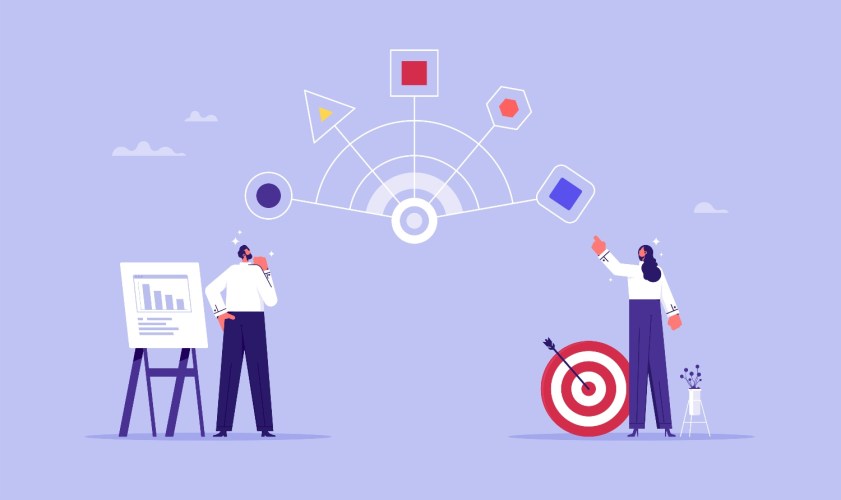It’s true, your business can outgrow your customer relationship management (CRM) system. What once felt like the perfect fit for your small or medium business (SMB) could in fact be the one thing that’s now holding you back. Instead of scaling, your CRM has become a bottleneck, costing you time, opportunities, and even revenue, making it harder to manage customers, close deals, and keep your team productive.
These aren’t just minor inconveniences, but more warning signs that you need better business tools to support your growing business. Let’s explore the top signs it’s time to upgrade your CRM.
What you’ll learn:
- Outgrowing your customer relationship management (CRM) tool?
- What are the pros of upgrading your CRM?
- Top 10 signs it’s time to upgrade your CRM
- Steps to upgrade your CRM
- How to upgrade your Salesforce CRM
- Upgrade your CRM to keep up with the times
Outgrowing your customer relationship management (CRM) tool?
If your business is struggling to keep up with customer demands or if your CRM is no longer meeting your needs, it may be time to consider an upgrade to simplify operations, enhance customer engagement, and increase growth. Let’s first kick it off with the benefits of upgrading, then get into the 10 signs.
What are the pros of upgrading your CRM?
Upgrading your CRM isn’t just about getting “fancy” new features. It’s about investing in your SMB’s future and enabling it to compete with large enterprises. Here are a few benefits of upgrading your CRM.
Start with SMB Basics
- More efficient operations: CRMs are your hub for smooth operations, task management, and workflow management. And with automation, you can focus on more complex aspects of your business, and build customer relationships.
- Better customer insights: Integrated CRMs offer a 360-degree view of your customer journey. They help understand your customers and personalize their experiences to boost loyalty. And, a data-backed CRM tracks every interaction and turns it into an opportunity.
- Personalized marketing: Intelligent CRMs understand the value of personalization in marketing for smaller teams. An SMB marketing tool gathers customer data like demographics, purchase history, and interactions for better segmentation and personalized campaigns.
- Increased security: Advanced CRMs like Salesforce offer data encryption, and regular security updates to safeguard your information.
- Scalable business capabilities: A sustainable CRM gives you the flexibility to scale as your business grows. You can easily add team members, more data, and customize features as needed, so you only pay for what you use.
- Improved user satisfaction: Your team can get started with minimal training, which drives more productivity. For example, Starter Suite is built for SMBs, and whether you’re a solopreneur or have a lean team, you can start using it from day one.
- Artificial intelligence (AI) capabilities: An AI-powered CRM helps you personalize and deliver better customer experiences, predictive analytics, and intelligent automation that goes beyond traditional automation.
Pro Tip: If you’re already a Salesforce customer, you can activate Foundations and try out Agentforce 360. You can implement an AI agent to handle various tasks, such as boosting your sales pipeline, 24/7 customer service, commerce customization, end-to-end marketing, and even team productivity

Top 10 signs it’s time to upgrade your CRM
Growing businesses are prioritizing tech upgrades to attract new customers and boost revenue. In fact, our latest Small and Medium Business Trends report states that 76% of SMBs spend more on technology now than ever before. If you’ve been wondering if your SMB requires a CRM upgrade, here are the top signs it’s time to upgrade your CRM.
1. You maxed out your customer limit
Struggling to handle prospect and customer data? Are you constantly running into storage limitations? Or maybe you have processing delays? Any one of those are a clear sign you’ve outgrown your CRM tool. Growing your team, your marketing leads, and your customer database are all wonderful things, don’t let your CRM hold you back from expansion.
Solution: Choose a customer database that lets you increase your volume to scale with your business. CRMs tailored for solo entrepreneurs and SMBs are made to fit from one-person operations to large teams. Find a scalable CRM to ensure it can accommodate your future needs, offering flexible features like increasing users, customizable workflows, and more storage capacity to help you scale without frequent system overhauls.
2. You spend a lot of time manually fixing performance issues
If you spend time waiting for CRM dashboards to load or repeating work due to system crashes, you’re losing both productivity and morale. Regular CRM performance issues are a huge sign that your system can’t handle your business needs.
Solution: Consider a cloud-based CRM like Starter Suite that provides real-time updates, stability, and improved speed. While it reduces the likelihood of system crashes, it also handles all back-end maintenance, ensuring the system runs efficiently.
3. You lack the features required for growth
If you often find yourself saying, “I wish these features were available in my CRM”, or creating workarounds because it doesn’t have the features you need, it’s time for a change. A CRM for small business should offer the features you need for growth. Feature gaps can create silos and prevent you from having a unified view of your customer journey.
Solution: Look for a CRM that comes with integration capabilities. It should support various CRM integrations like partner apps, email marketing tools, real-time analytics, and omni-channel experiences. For smaller teams, try business tools like Pro Suite, so you can integrate your CRM with the AppExchange and integrate the tools you need to scale.
Wherever you are — just get started.
No matter where you are on your journey as a business owner, you can get started with Starter Suite for free — the CRM made for growth.

4. Your CRM has a poor user experience
User experience can make or break CRM adoption within your team. If your team needs extensive training to perform basic tasks or use new features, that’s a problem. Complicated dashboards, interfaces, and workflows can hinder productivity and discourage your team from using the CRM.
Solution: Make sure your teams have productive and agile tools that simplify workflows within CRM and are easy to use. When your team can quickly find what they need, they can view the data effortlessly, and collaborate easier.
5. Your CRM’s data isn’t aligning with business decisions
Your CRM is your single source of truth — you can count on it for data-driven decision-making. However, your decisions and business operations will be as good as the data you own, and how you connect it. So if you’re dealing with duplicate entries, missing information, or spending hours cleaning up data, your CRM is failing to do its job.
Solution: Opt for a CRM that offers advanced data validation, reporting integration, and artificial intelligence (AI) capabilities to help. Ensure your CRM has data encryption using industry-standard protocols and a security layer for your data. By converting sensitive customer information into unreadable formats for unauthorized users, it safeguards your data from breaches.
6. You’ve been vulnerable to security breaches
If you have had a data breach or been hacked in any way, you’re CRM isn’t secure. SMBs are prime targets for 43% of cyberattacks. CRMs with outdated security protocols put your business at risk. If your system lacks advanced encryption features or doesn’t update its security measures regularly, you may be prone to unnecessary risks.
Solution: Prioritize a CRM that follows data security practices and offers features such as multi-factor authentication (MFA), data loss prevention (DLP), access controls, regular security updates, and anomaly detection to proactively prevent breaches.
7. You receive poor customer feedback about your service
Listen to your customers because they’re your top brand advocates. If they repeatedly report negative customer experience, service delays, and slow order processing, it could be your CRM tool. Your customer service and sales teams can’t deliver personalized experiences or close deals if your CRM isn’t delivering.
Solution: Look for a unified CRM that offers a 360-degree view of customer interactions, concerns, and behavior. A service for small business tool can help you deliver great customer service through multiple features, including self-service, email automation, and real-time support.
Build a loyal customer base with smarter, faster service solutions.


8. You’ve failed to meet compliance, causing violations
Regulatory requirements like the General Data Protection Regulation (GDPR) and the California Consumer Privacy Act (CCPA) demand solid data protection measures. If your CRM lacks features for consent management, data retention policies, or audit trails, you could face significant compliance risks and damage your brand reputation.
Solution: Be sure to look for a CRM built with compliance requirements into the system. An up-to-date CRM conducts regular updates to meet any new privacy standards. Salesforce CRM takes compliance very seriously, and provides features to help customers maintain code.
9. You have limited automation and AI capabilities
Growing SMBs are nearly twice as likely to invest in AI than declining SMBs. If your CRM lacks AI-powered features like predictive analytics, automated lead scoring, data-backed forecasting, and 24/7 customer service, you’re missing out on big competitive advantages.
Solution: Consider an AI CRM to automate routine tasks, identify sales opportunities, and gather insights to make well-informed business decisions. This leads to higher conversion rates, faster sales cycles, and improved customer loyalty.
10. Your CRM doesn’t connect your teams
A CRM should support your team’s collaboration and connection, not limit it. It can become a huge bottleneck for you when your team grows, but your database doesn’t. If your CRM isn’t connecting your team members working remotely, your prospects, and your customers — it’s time to upgrade.
Solution: To boost collaboration, look for a CRM that offers flexible licensing models that make adding users easy. Go for a CRM that can be easily integrated with team collaborative tools like Slack for dashboards, quick sync huddles, automated reminders, summarizing meetings and calls.
Steps to upgrade your CRM
All set to upgrade your CRM? We’re here to guide you through the process. These five steps will help you get started:
Step 1. Review your needs to scale
Before upgrading to a new CRM, review features, access controls, and the number of seats you’ll need for your team. We recommend creating a prioritized list of must-have features, capabilities, and user limits to narrow down the best CRM for your business needs.
Step 2. Compare CRM tools
Once you have your list of requirements, look for ways you can scale with one tool. Consider your current needs and where your business will be in five years, ten years, or even twenty years (you really have to plan for the future). Compare the following factors while choosing a CRM:
- Research CRM tools: Read user reviews, try out demos, and learn the product roadmap to ensure the CRM aligns with your future needs.
- Evaluate features: Review how each CRM’s capabilities match your business needs, and focus on features that support your daily operations and long term goals.
- Assess integration abilities: Be sure it offers custom integration capabilities so you can test how your CRM works with your current business platform and tools.
- Analyze scalability: Analyze immediate and long-term expenses as your team grows, including costs for additional users, more data storage, and advanced features.
- Estimate the implementation timeline: Consider the learning curve for your team and establish clear steps to help everyone adopt the new CRM seamlessly.
Step 3. Plan the migration
Once you’ve found the right CRM for you, create a migration strategy with clear timelines, assigned responsibilities for your team, and identify any potential roadblocks. To prepare your data, start auditing it thoroughly. Remove outdated or unnecessary information.
Organize your data by categorizing and standardizing fields (like customer email or address) to ensure consistency in the new system. Set up validation processes, such as automated checks or sample data imports, to catch any inconsistencies early on.
Step 4. Migrate your data
Ensure all your important customer data is ready for migration. With an import of a CSV or trusted file, you can move your data to your CRM seamlessly.
Not only that, but you can work with your CRM provider to customize the new dashboards for your team. This step involves setting up user roles, customizing the interface, configuring workflows, and integrating it with other business tools.
Step 5. Monitor and optimize
Once your new CRM is set up, you can then track key performance indicators (KPIs) and observe user adoption rates, system performance, and workflow efficiency. And, your CRM can collect timely feedback from your team and make the necessary adjustments to improve performance.
How to upgrade your Salesforce CRM
We’ve built Starter Suite and Pro Suite exclusively for small and growing businesses like yours. Get your CRM up and running quickly with Starter Suite. As your business grows, activate Pro Suite to access advanced customization, omni-channel routing, forecast management, and AI automation.
And, if you’re already a Salesforce customer, you can upgrade with Foundations and try out Agentforce. Activate Salesforce Foundations using the following steps:
- Log in to your Salesforce account
- Select “Salesforce Foundations” in the “Set Up” nav
- Click on “Add to my Contract”
- Add Salesforce Foundations to your cart
- Check out and go back to “Set Up” to start using Foundations
(Back to top.)
Upgrade your CRM to keep up with thrive in these times
Listen to the signs when it’s time to upgrade your CRM. It can help you identify better leads, deliver faster service, and keep your data secure. From commerce and marketing to customer service and sales, Salesforce helps you scale.
Start your journey with Starter Suite today. Looking for more customization? Explore Pro Suite. Already a Salesforce customer? Activate Foundations today to activate Agentforce 360.
AI supported the writers and editors who created this article.




































